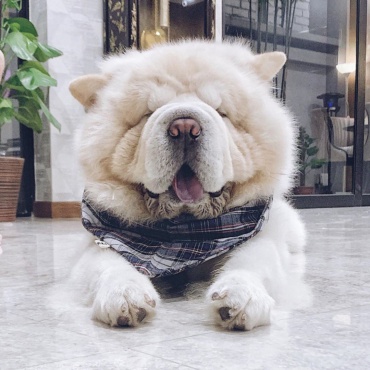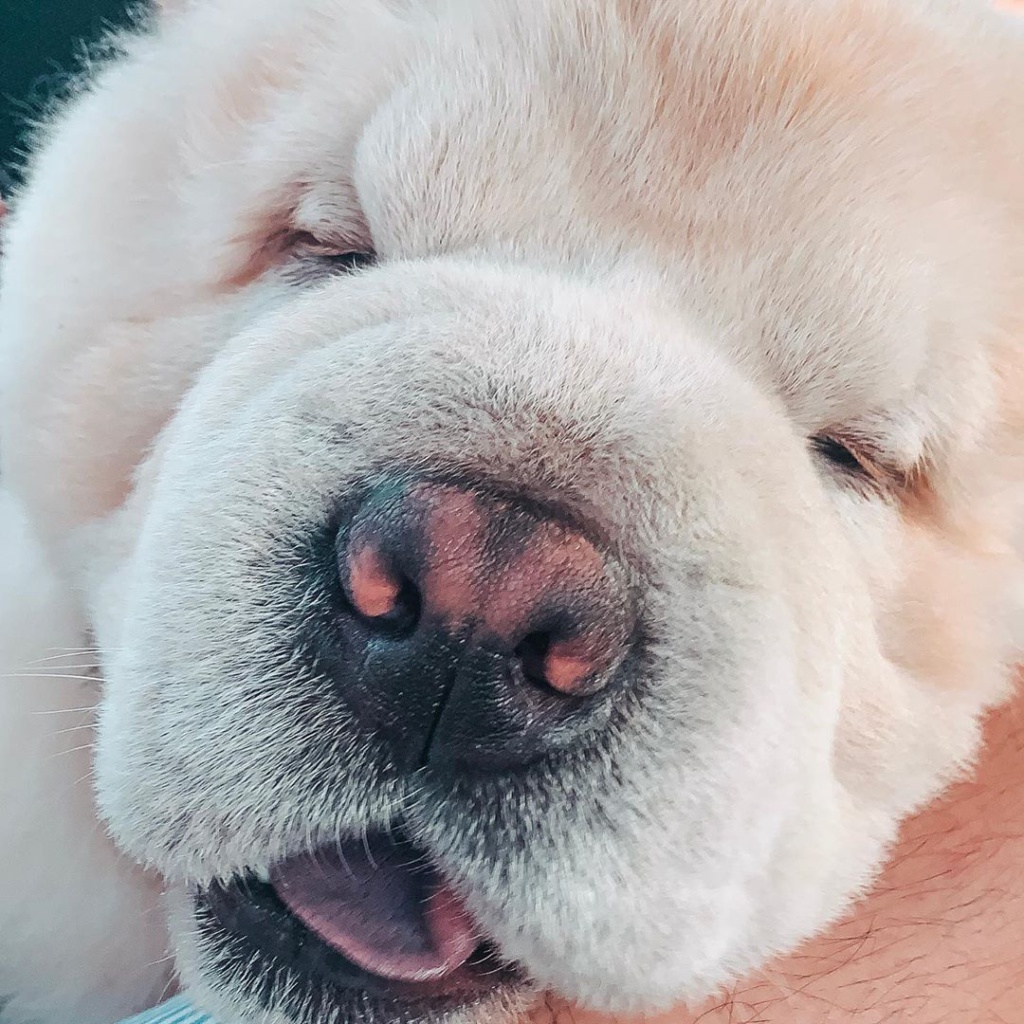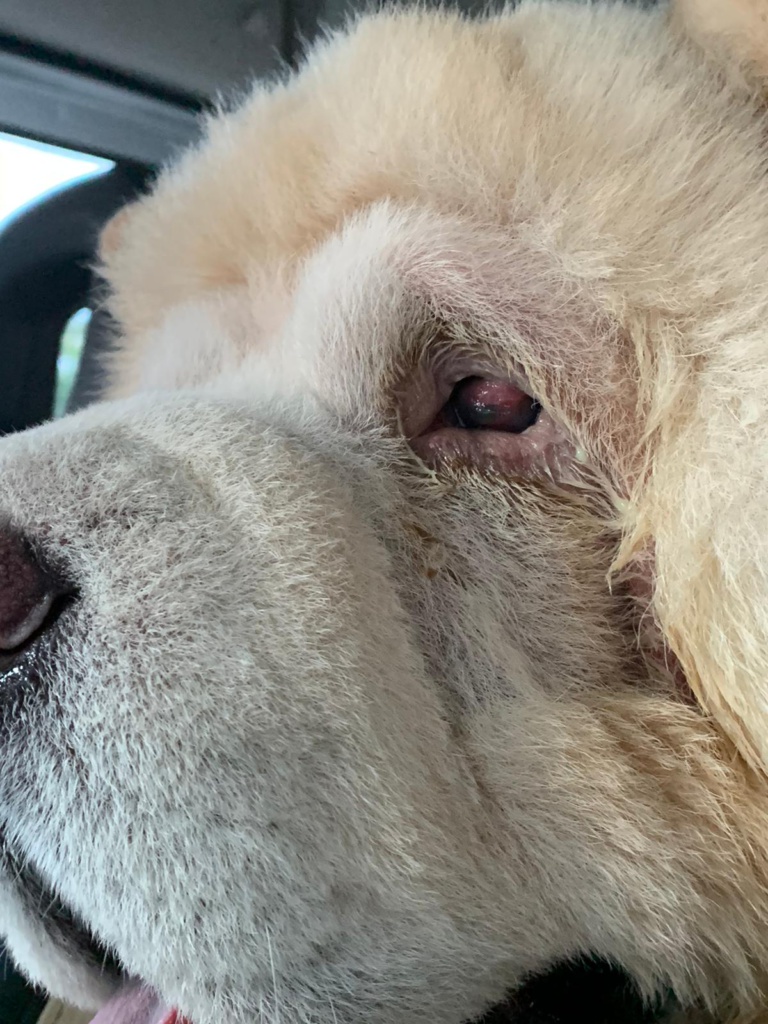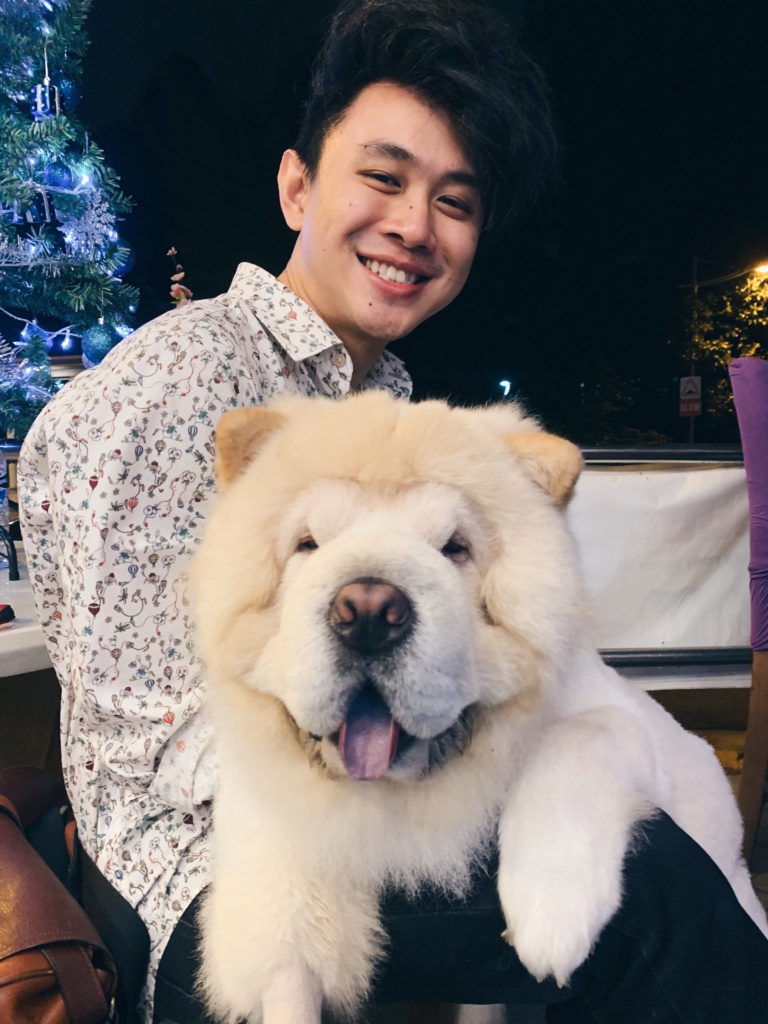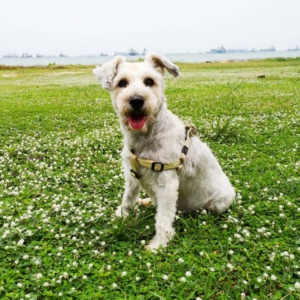To sterilise or not to sterilise, that is the question that many pet parents face at some point in time. But what happens after the decision is made?
So you’ve finally come to a conclusion after weeks and weeks of researching the pros and cons of sterilising your furry mate. The tough part’s over, right? Not necessarily!
To ensure that the surgery and recovery process is as smooth as it can get, these are some of the things that all pawrents should consider during the planning process.
When to do it?
We often hear advice like “You should spay her after a few rounds of heat” or “Let her experience motherhood first” or “Male dogs don’t need to be sterilised” etc. Then there’s the other recommendation that it’s safe to sterilise puppies from 4 months old.
Personally for me, I spoke to three vets about this issue and all of them gave me differing advice. Even within veterinary science, there are different schools of thought. Initially I had planned to spay Duoji at 6 months, then it was pushed back to 8 months cos she just looks so young and baby-ish. I didn’t have the heart to subject her to surgery. Ultimately she was spayed at 13 months old, after she reached adulthood. Incidentally, she had her first heat at around 9 months old. In a way I was reassured that she had developed properly physically before surgery.
At the end of the day, every furkid is different and there’s no right timing to do it. There are some underlying conditions, such as undescended testicles, of which sterilisation is recommended but otherwise, best to seek a trusted vet’s opinion and make an informed decision.
Where to do it?
For something as important as a surgery, it would be unwise to just waltz in to any vet clinic. I strongly recommend all pawrents to begin searching for a trustworthy and reputable vet in the early stages, before you trust them with any operation procedure.
Check online reviews or chat with other pawrents. Better still, visit them for a simple check-up or vaccination – you’d want to assess the clinic, its staff and facilities, whether it’s a good experience overall, before you make your final decision.
Location is also an important consideration. Not only would you save time travelling to and fro (or $$ for those who don’t drive), the journey would also be more comfortable for your furkid. This is particularly important for furkids who get anxious when travelling in cars. Imagine having to endure a long car ride while feeling groggy and in pain after surgery.
Sterilisation fees vary across different vet clinics as well, so if price is an area of concern, best to call up your shortlisted clinics to enquire before confirming the appointment.

Any add-ons?
During the procedure, your furkid will be under general anesthesia so why not plan the sterilisation surgery to coincide with procedures that you may want/need? Common ones include dental scaling, extraction of teeth etc. This way, you’ll only need to subject your furkid to general anesthesia once.
E-collar
Wearing an e-collar is a must for furkids post-surgery as it helps to prevent them from licking or disturbing their wound. Most incisions are held together by self-dissolving threads which can come apart when in contact with their saliva, putting the wound at risk of infection.
If your dog is fussy, it’s best to get him or her used to the feeling of wearing an e-collar at least 2 weeks prior to surgery. Ease them into it by keeping the initial duration short, then slowly extending the time, with plenty of treats in between, of course.
During this step, you can also take the chance to check the fit of the e-collar. The last thing you want is for your furkid to reject the e-collar or try to shake it off and risk aggravating the wound. Or worse, to find out that the e-collar doesn’t fit on the day of surgery and you have to scramble to get a replacement.

Grooming
Post-surgery, you won’t be able to shower your furkid for around 10-14 days so do plan a shower before the appointment day to keep your furkid clean and comfortable. I strongly recommend sending your furkid to full grooming before that – a shorter and neater fur coat can come in handy especially since you won’t be able to shower or brush their coat much during the recovery phase.
Setting up a confinement area
During recovery, your furkid would have to minimise movement and get plenty of rest. That means no running, jumping about or rough play. If you don’t already have a playpen or crate, the next best way is to set up a temporary confinement area in a spare room. This would be the space that your furkid is confined in for the next 14 days, ideally, so make it comfortable with soft blankets/pillows etc.
But if your furkid is as active as mine, then you will have to devise some additional ways to keep them safe and out of trouble. You might even want to pre-plan these stop measures and test them out first to make sure it’s foolproof.
In Duoji’s case, she was actually almost normal by the 3rd day after surgery, which means it was impossible to keep her confined for long periods of time. I ended up allowing her to have some pockets of free roaming time under close supervision from day 5 onwards but with makeshift barricades (think rows of chairs to block the stairs, leg massager and random metal tins to block the sofa etc) around the house to prevent her from accessing areas that I deem dangerous.

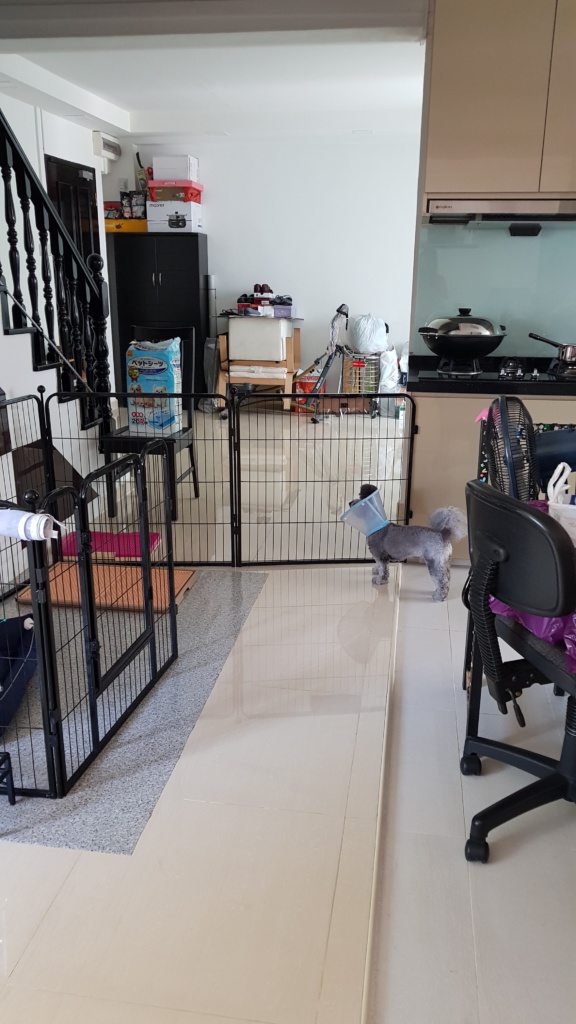
Caregiver
After the surgery, your furkid will be weaker than usual and require extra care. Hence it’s best to have someone responsible and attentive around to take care of them round the clock, especially for the first few days. For working pawrents, that means you might have to make arrangements to work from home or plan your leave days around the surgery date.
In my case, I planned the surgery on a Wednesday so I’ll have Thursday through Sunday to take care of Duoji before I head back to work on Monday.
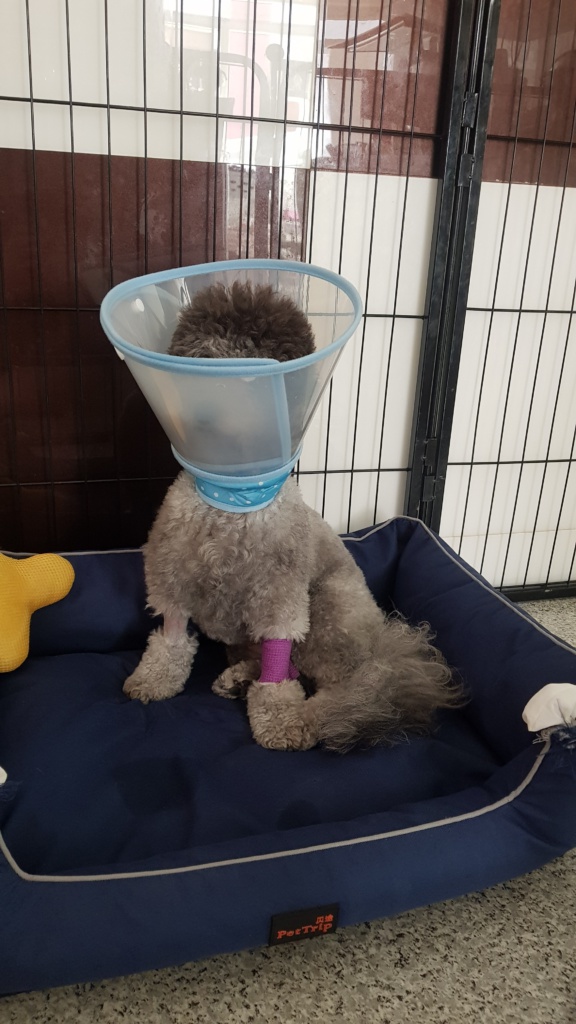
Another reason to go for full grooming is so that the shaved leg wont look too weird.

Fasting
The night before surgery, your furkid would be required to fast so do remember to stop all food and treats by the stipulated cut-off time. Don’t forget to keep the water bowl too.
Keeping record
So you and your furkid have made it through the surgery and all safety measures are in place. What’s left is to ensure that the wound heals properly. It’s very important to keep the wound clean and dry – follow the aftercare instructions given by your vet closely.
As an additional step, you might want to keep a record of your furkid’s healing progress. Check for open/split wounds or signs of infection like pus and bleeding. The easiest way is to take a photo of the wound everyday, ideally using the same device and under similar lighting conditions. This way, you can compare the progress and show your vet if you suspect anything amiss.
By day 5, Duoji’s wound looked almost closed up and the swelling and redness had gone down already. Eventually the incision wound will fade away and be covered by the belly fur. Now, almost 7 months on, I cannot even locate the scar anymore.
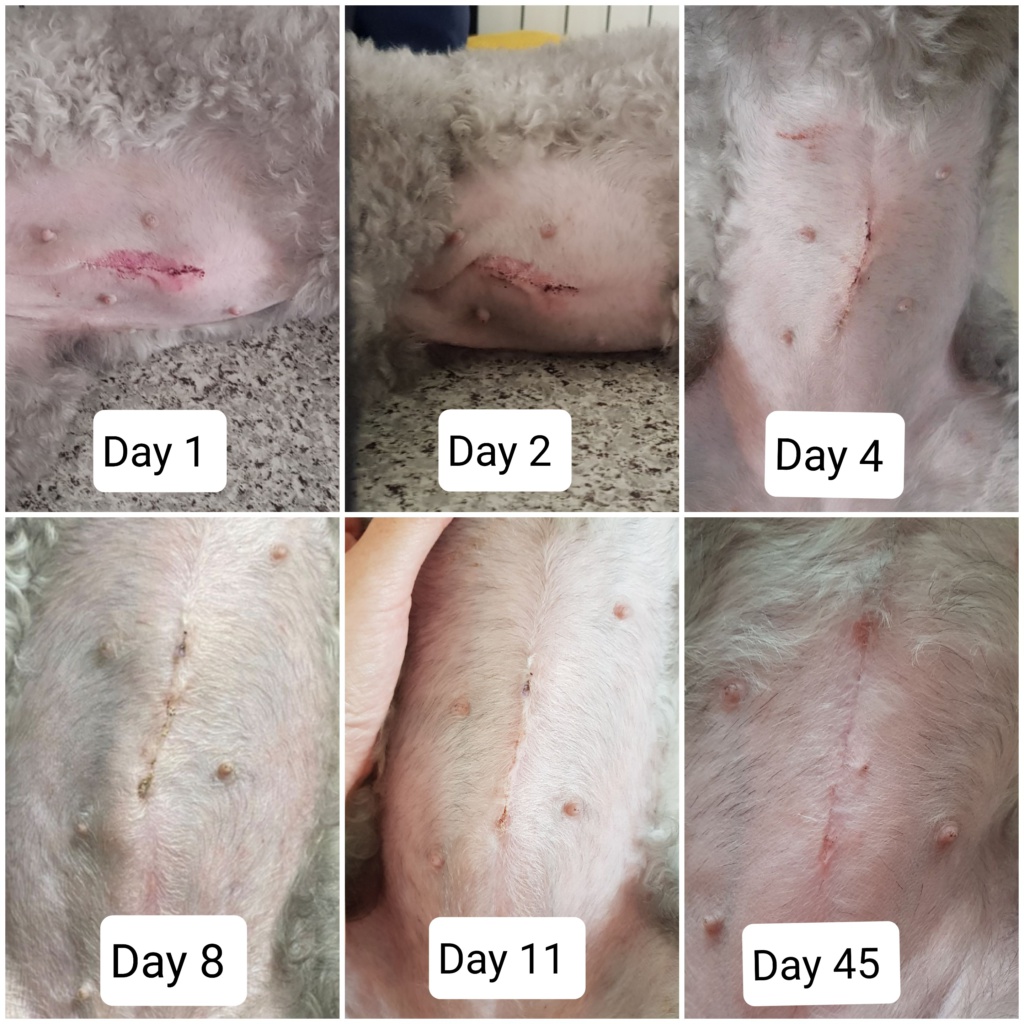
Hopefully the above tips are helpful to pawrents who have upcoming surgeries and are unsure of what to expect.
Until the next post!
@duojipoodle


